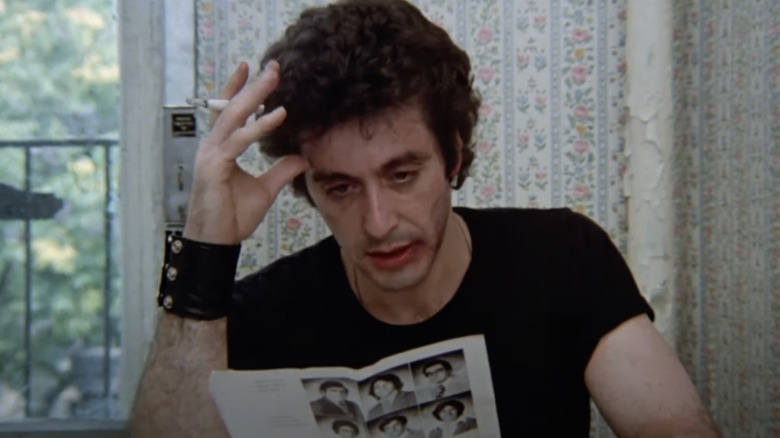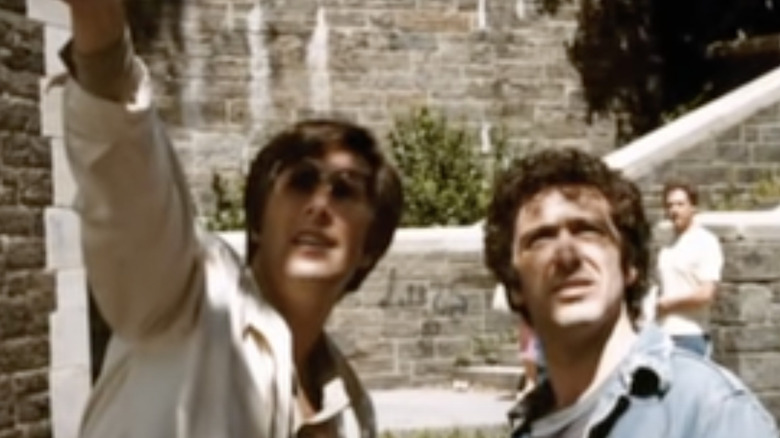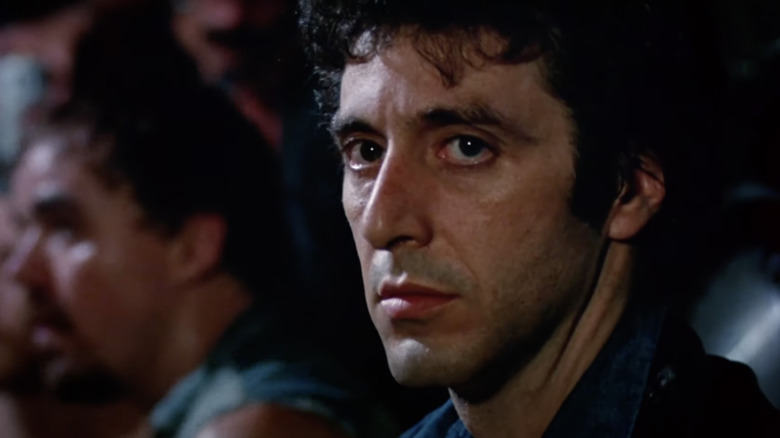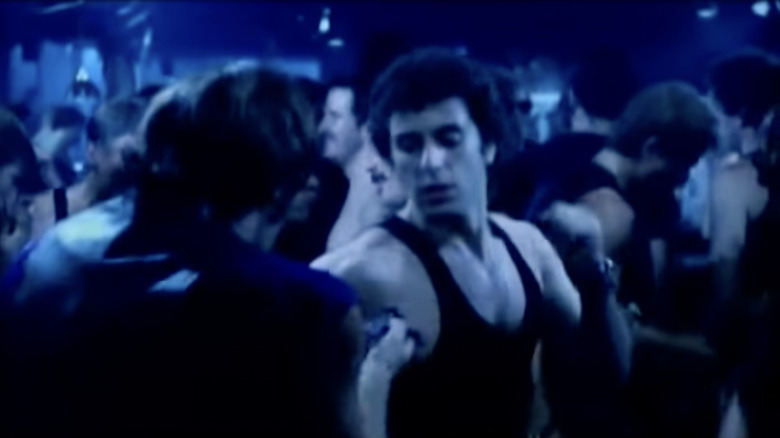Why Cruising Was Al Pacino's Most Controversial Film
We love Al Pacino, which is why we can't (and won't) stop talking about him. The former comedian has a legendary career, spanning five decades and counting, which has made him one of the most recognizable stars in Hollywood and earned him millions. Over the course of a career as long as Pacino's, any actor would eventually find controversy of some magnitude, and Pacino is no exception. Although the actor has taken some inappropriate roles in the past, the 1980 film "Cruising" can't be topped, as the film itself — not just Pacino's part — was at issue.
In the movie, Al Pacino plays NYPD Officer Steve Burns, who is sent undercover to investigate a series of murders after body parts start turning up in the Hudson River. Police suspect that the killer frequents New York's leather bars to pick up victims that willfully follow him into secluded spaces where the killer overpowers and stabs them to death. Burns matches the victims' appearance, and he sees the case as a way to advance his career, so he gets himself a leather jacket, paints his eyebrows, and enters this foreign world of uninhibited same-sex desire.
Filmed in 1979, this subject matter was pretty radical for a mainstream movie, but "Cruising" was not the representation that a lot of gay people wanted — and that was just one of the hurdles director Willaim Friedkin and the production team had to jump. The film was so scandalous that its 2007 DVD release was accompanied by a two-part documentary about its production and all the controversies surrounding it. Let's get into some of these issues.
Gay activists protested Cruising
Early in the filming of "Cruising," gay activists got wind of the upcoming film and worried that its portrayal of liberal sexuality and extreme violence would feed into the negative stereotypes they were working so avidly to reverse.
According to the New York Times, July 26, 1979, was a day of action for gay activists seeking to halt the production of "Cruising." First, representatives of the National Gay Task Force requested that Mayor Ed Koch withdraw the film's shooting permit (a request he denied, citing censorship concerns). Then, there was a march of about 1,000 protestors from New York's Pier 40, where the production team was headquartered, to a filming location in Greenwich Village, where they blocked traffic in Sheridan Square for half an hour. A hundred police officers were dispatched to disperse the crowd, and two protestors were arrested.
Even with the demonstrators cleared from the area, local businesses and residents of Christopher Street temporarily stopped the production of "Cruising" by locking their doors and posting signs saying "Stop the Movie 'Cruising,'" forcing the team to move a short jaunt north, out of the Village (via The Village Voice). On August 20, a group of 700 activists celebrated this victory by marching from Sheridan Square to the new location. The march turned violent as police officers on horseback charged a crowd on West Street, brutally attacking one protestor before arresting him for "endangerment, resisting arrest, and harassment." The success of the protests certainly wasn't without its casualties.
Activists attempted to sabotage the filming of Cruising
Protesting was not the only form of direct action taken by gay activists in attempt to stop "Cruising" from ever making it to theaters — they also directly meddled with the filming itself. In the documentary "Exorcising Cruising," Mark Johnson, a production executive, remembered, "There was the deliberate attempt to make a lot of noise, usually with whistles and some sort of blasters, some air horns ... [to] ruin the sound takes." Richard Cox, who plays the suspect Stuart Richards, reported that activists would gain access to adjacent apartments and blast music during filming. Because of the consistent disruptions, much of the film's dialogue had to be dubbed. It wasn't just the audio that gay activists targeted, as Johnson also remembered activists climbing onto nearby roofs to direct mirrors onto the set and ruin the lighting.
Perhaps because of these efforts to sabotage "Cruising" in its early stages, the film crew became unnecessarily intrusive — and, at times, combative — toward the surrounding community. The anti-"Cruising" journalist Arthur Bell investigated the film's production for The Village Voice, reporting on September 3, 1979, that the film crew repeatedly disrupted the lives of New Yorkers both in the Village and elsewhere in Manhattan. They blocked off streets, restricted residents' access to apartment buildings where scenes were being filmed, and cut the electricity of apartments next to where they shot to reduce background noise — all without advance warning. One resident even reported that her apartment door's lock had been superglued in retaliation for her complaints about a prop man illegally covering up her mailbox label.
Cruising featured real members of the gay leather subculture
Looking back on the controversy surrounding "Cruising," journalist Jason Bailey wrote for The Village Voice in 2018 that some leather gays felt the backlash against the film was more concerned with maintaining respectability in the eyes of heterosexual society than standing in solidarity with the gay community.
Director William Friedkin's interview for the "Exorcising Cruising" documentary supports this. He said, "There were two factions of the gay world then. And there were nights when we were filming when there were thousands of people yelling and screaming and throwing cans and rocks and bottles, and joining us on our side were more thousands of guys who supported the leather bars."
While these numbers are likely exaggerated, Bailey quotes John Devere, the editor-in-chief of the gay magazine Mandate. He was cast as an extra for "Cruising," as were many other gay men, and he reported in February 1980 that "more than 1,600 gay men participated in the filming of 'Cruising.'" Clearly, the gay community did not have a unanimous response to the film, which highlighted the internal issues the community had to grapple with while working to gain acceptance in mainstream society.
Cruising's plot was influenced by the alleged murders of gay men by Paul Bateson
When planning the story for "Cruising," William Friedkin sought inspiration from the true story of a serial killler whom he had previously worked with when filming "The Exorcist." Paul Bateson was the real-life radiologist's assistant who appeared in the "Exorcist" scene where the possessed Regan gets a brain examination. Bateson was later convicted for the murder of Addison Verill, a film critic for Variety, after the two had a sexual encounter (via The New York Times). The newspaper reported on April 7, 1979, that following Bateson's conviction, he admitted to his friend, Richard Ryan, that he had also killed other men, dismembered their bodies, and disposed of them in the Hudson River. Sound familiar?
Well, prior to Bateson's conviction, Friedkin had visited him at Rikers Island, where the two "had a very pleasant chat," Friedkin said in part one of the documentary on the film. Doing your research is important, but talking to a killer of gay men to get inspiration to make a movie that showcases their brutal deaths might be a bit extreme.
The MPAA thought Cruising was too explicit
To secure an R rating for "Cruising," William Friedkin told Alex Simon for Venice Magazine in 2007 that he had to send the film back to the ratings board of the Motion Picture Association of America 50 times. Friedkin had to cut 40 minutes from the film, spending $50,000 on MPAA fees alone. This footage is now lost, but it became the inspiration for "Interior. Leather Bar," a 2013 film in which directors James Franco and Travis Matthews try to recreate the process of filming "Cruising" within the New York leather bar scene.
Over the years, attitudes toward "Cruising" have changed, and William Friedkin has even begun to understand why there was so much controversy around the film. In 2007, Friedkin said, "In hindsight, I realize that 'Cruising' was not the best foot forward that you can put as an argument for the acceptance by heterosexual people of the gay lifestyle. It was never meant to be emblematic of anyone's lifestyle, but it did exist. And to me it was the background of a murder mystery, period. Yet it became a cause celebre for others to try and show that certain insensitive people like myself were using the mainstream media to slander gay people, which could not have been further from the truth."
There has been growing interest in the film from gay viewers in recent years, too. So it looks like the future of "Cruising" may be brighter than its past. "Cruising" may not rank best or worst as far as Al Pacino movies go, but it has certainly garnered some serious notoriety. If you like crime thrillers or gay cinema, it's a must-see, even if it's just so that you can shape your own personal opinion of it.





